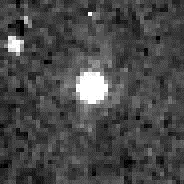(145452) 2005 RN43
表示
| (145452) 2005 RN43 | |
|---|---|

| |
ハッブル宇宙望遠鏡によって2010年4月に撮影された(145452) 2005 RN43の画像
| |
| 仮符号・別名 | 2005 RN43 |
| 小惑星番号 | 145452 |
| 見かけの等級 (mv) | 20.1[1] |
| 分類 | 太陽系外縁天体(TNO) キュビワノ族[2][3] 分離天体(DES)[4] |
| 発見 | |
| 発見日 | 2005年9月10日[5] |
| 発見者 | Andrew Becker[5] Andrew Puckett[5] Jeremy Kubica[5] |
| 発見場所 | アパッチポイント天文台[5] |
| 軌道要素と性質 元期:2022年8月9日(JD 2459800.5)[2] | |
| 軌道の種類 | 楕円軌道 |
| 軌道長半径 (a) | 41.8669 au[2] |
| 近日点距離 (q) | 40.5869 au[2] |
| 遠日点距離 (Q) | 43.147 au[2] |
| 離心率 (e) | 0.03057[2] |
| 公転周期 (P) | 270.9 年(98947.6 日)[2] |
| 軌道傾斜角 (i) | 19.216°[2] |
| 近点引数 (ω) | 170.397°[2] |
| 昇交点黄経 (Ω) | 187.04°[2] |
| 平均近点角 (M) | 351.606°[2] |
| 最小交差距離 | ≈ 2029年6月15日[6] ±9 日 |
| 物理的性質 | |
| 平均直径 | 679+55 −73 km[7] |
| スペクトル分類 | IR–RR (赤)[7] B–V=0.95±0.02[8] V–R=0.59±0.01[8] V–I=1.08±0.02[8] |
| 絶対等級 (H) | 3.89±0.05[7] 3.9[2] |
| アルベド(反射能) | 0.107+0.029 −0.018[7] |
| ■Template (■ノート ■解説) ■Project | |
(145452) 2005 RN43とは、キュビワノ族に属する太陽系外縁天体である。推定直径は679+55
−73 kmである[7]。2005年9月10日、ニューメキシコ州サンスポットのアパッチポイント天文台でAndrew Becker、Andrew Puckett、Jeremy Kubicaによって発見された。ブラウンは、(145452) 2005 RN43が準惑星である可能性があると推定している[9][10]。
分類
[編集]小惑星センター(MPC)は、(145452) 2005 RN43をキュビワノ族として分類している[3]。しかし、この天体は19.3度の軌道傾斜角を持っているため、Deep Ecliptic Survey(DES)は分離天体として分類している[4]。
13の衝で119回観測されており、1954年までのプレカバリー画像が存在する[2]。
脚注
[編集]- ^ “AstDys (145452) 2005RN43 Ephemerides”. Department of Mathematics, University of Pisa, Italy. 2009年12月7日閲覧。
- ^ a b c d e f g h i j k l m “JPL Small-Body Database Browser: 145452 (2005 RN43)”. 2022年6月15日閲覧。
- ^ a b “MPEC 2009-R09 :Distant Minor Planets (2009 September 16.0 TT)”. 小惑星センター (2009年9月4日). 2010年1月8日閲覧。
- ^ a b Marc W. Buie. “Orbit Fit and Astrometric record for 145452”. SwRI (Space Science Department). 2009年10月4日閲覧。
- ^ a b c d e “List Of Transneptunian Objects”. Minor Planet Center. 22 August 2016閲覧。
- ^ JPL Horizons 場所: @sun (近日点は、Deldotが負から正に変化するときに発生する。近日点の時間の不確実性は3シグマである。)
- ^ a b c d e Vilenius, E.; Kiss, C.; Mommert, M. (2012). “"TNOs are Cool": A survey of the trans-Neptunian region VI. Herschel/PACS observations and thermal modeling of 19 classical Kuiper belt objects”. Astronomy & Astrophysics 541: A94. arXiv:1204.0697. Bibcode: 2012A&A...541A..94V. doi:10.1051/0004-6361/201118743.
- ^ a b c Belskaya, Irina N.; Barucci, Maria A.; Fulchignoni, Marcello; Lazzarin, M. (April 2015). “Updated taxonomy of trans-neptunian objects and centaurs: Influence of albedo”. Icarus 250: 482–491. Bibcode: 2015Icar..250..482B. doi:10.1016/j.icarus.2014.12.004.
- ^ Michael E. Brown. “How many dwarf planets are there in the outer solar system? (updates daily)”. カリフォルニア工科大学. 2011年10月18日時点のオリジナルよりアーカイブ。2011年8月25日閲覧。
- ^ Tancredi, Gonzalo (2009), “Physical and dynamical characteristics of icy "dwarf planets" (plutoids)”, Proceedings of the International Astronomical Union 5: 173–185, Bibcode: 2010IAUS..263..173T, doi:10.1017/S1743921310001717

